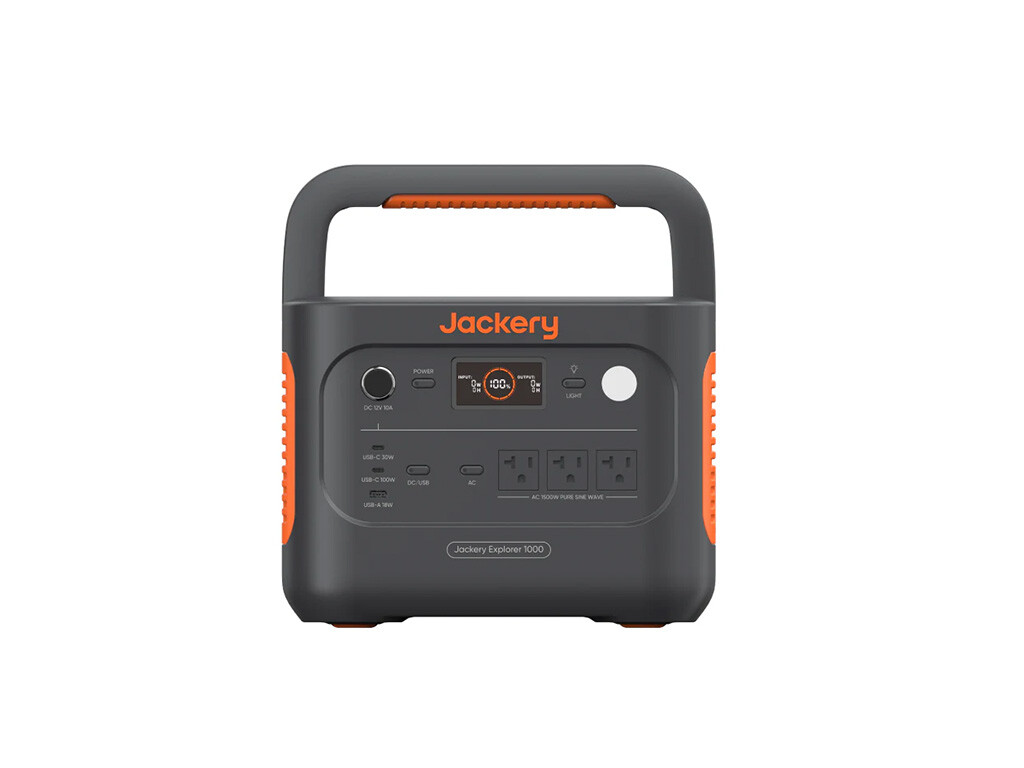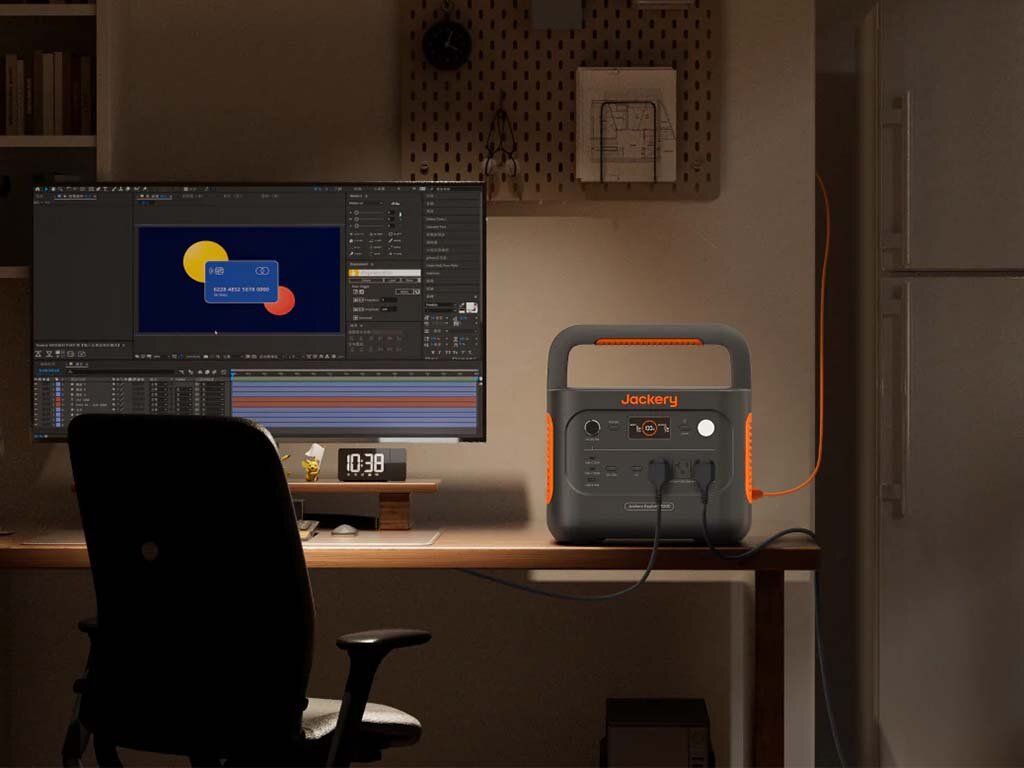Ready to check out one of the latest and greatest portable power stations for your outdoor escapades? This Jackery Explorer 1000 v2 Power Station review breaks down everything you need to know about an updated version of a crowd-favorite solar generator.
We’ll cover the main updates and discuss how much they enhance this power station. Then we’ll review the details so you have the full picture. Finally, we’ll compare it to top rivals so you can decide if it’s worth your investment.
Whether you’re prepping for a road trip, an off-grid adventure, or want a little backup power at home, this review of the Explorer 1000 v2 can help you make the best decision.
We carefully select the products and services we link to. If you buy through our links, we may earn a commission. There’s no extra cost to you and it helps us provide this information.
What’s New: Jackery Explorer 1000 v2
The original Jackery Explorer 1000 was one of the brand’s best solar generators. And for good reason. It’s an ideal size for portability yet still packs a powerful punch. Yet this second-generation update is a massive step forward. It sticks to the core features that make it an ideal power station, but adds some essential upgrades to stay on top of the power station industry.
There are three major upgrades that Jackery brings with this new portable power station:
- 1,500W AC inverter
- LiFePO4 battery chemistry
- Super-fast AC charging
It’s really hard to say which of these is the most important because they’re all such big jumps ahead. The AC inverter’s boost to 1,500W is a big deal, allowing you to use devices that are 50% more powerful as compared to the 1,000W of the outgoing model.
But for many people, the change in battery type is going to be crucial. The previous generation used an NMC type of lithium-ion but it was only rated for about 500 cycles while keeping 80% of its charge. Now, the Explorer 1000 v2 uses the gold-standard LiFePO4 (LFP) battery chemistry. It is rated for 4,000 cycles while keeping at least 70% of its charge.
This just went from a device that can last about two years before degradation to now over 10 years of use!
Finally, the AC charging upgrade is not something to overlook. It decreases the changing time from a wall outlet from 7.5 hours down to an astonishing 1.7 hours. And it adds <20ms UPS functionality with pass-through charging. It’s now a top contender in the battery backup supply for sensitive electronics.
You still have 3 AC outlets, multiple USB ports (with faster USB-C rates), and a compact size. The solar input is also improved, now accepting up to 400W of solar panels.
In general, this updated Jackery Explorer 1000 v2 is a serious step up, and one that shows Jackery why Jackery has been a trusted name in the world of portable power stations for so long. As it rolls out these new features, it’s staying extremely competitive against the red-hot solar generator market.

|
Jackery Explorer 1000 v2 Portable Power Station |
1000 v2 on Jackery 1000 v2 on Amazon |

|
Jackery Solar Generator 1000 v2 + 1*200W Solar Panels |
Buy on Jackery Buy on Amazon |

Top Features, Capacity, and Specifications
Now let’s take a closer look at the features and specifications for the new Explorer power station.
AC Power Output
When you want to run devices off of a usual AC outlet (120V), the AC inverter is the key component to watch out for. And this power station now harnesses one that has a continuous rating of 1,500W. This is enough for large blenders, many microwaves, and some other relatively-large applications. It even includes home refrigerators.
This change from 1,000W up to 1,500W inverter is a major shift upward. And it comes with a 3,000W peak output, which can help for those short-duration device startup surges.
Battery Capacity and Chemistry
The battery capacity does move up a little bit, going from 1,002Wh before to now 1,070Wh with the Explorer 1000 v2. But as the model name indicates, this is meant to have a 1,000Wh battery (1kWh). If you want more, you can jump up to the Explorer 1000 Plus or bigger Jackery power stations.
But what everyone can be very excited about is the change in battery chemistry.
The new LiFePO4 lithium battery of the Jackery Explorer 1000 v2 Power Station is a serious game-changer when compared to the old lithium-ion (NMC) of the last generation. Many brands have moved over to the LiFePO4 (also known as LFP) and it was a sore point for some Jackery power stations.
Now that changes. This new battery can handle over 10 years of use while keeping 70% of its charge. That’s 4,000 cycles of use.

Charging Options
There are three ways to charge this Jackery power station:
- AC wall outlet: 120V at 15A is a seriously fast AC charging rate, making it so you can get a full battery in less than two hours. No worries if you forgot to plug it in overnight before the trip. Just plug it in while packing and you’re good to go.
- Solar panels: There are two separate solar panel inputs, which can both use up to 200W each. That means you can use 400W of solar panel, which in ideal conditions, could recharge fully in less than 3 hours. It can meet your power needs by fully recharging the battery (and more) with just sunlight.
- DC car charging: When you’re on the road, use the DC cigarette lighter cable to recharge the power station. It’s not the fastest charge (because cigarette lighters aren’t high-powered), but it’ll still get you topped off while driving.
Both the AC charging and solar panel inputs are big improvements from the last generation. And they’re both incredibly fast rates that anyone should be happy with.
Portability and Design
One of the best features of the Jackery Explorer 1000 v2 (and the original) is its compact and portable design. Nearly anyone, including children, can carry this device. And it doesn’t hog a ton of room in your gear.
At just 23.8 lbs (10.8 kg), this power station weighs less than 3 gallons of water. And its measurements of 9.72 x 8.82 x 12.87 in (247 x 224 x 327 mm) are just about the same as two shoeboxes stacked on top of one another.
Overall, you really can’t beat the portability of this device. If you tried to create something similar with all of the components, safety devices, and battery cells, you’d probably come away with something about three times the size and double the weight. It is truly remarkable how compact and lightweight Jackery is able to make this power station.

Interface and Outlets
Finally, it’s always worth knowing what the ports and outlets look like. And how you control and monitor everything.
Once again, this is a big step up from the past. This Jackery Explorer 1000 v2 now can connect with the Jackery app through WiFi or Bluetooth, opening up a world of easy control and monitoring. You can always know how much power is left, how much it’s charging at, and how much power you use. Just a quick glance at your phone from anywhere in the world. If you’re nearby and away from WiFi networks, Bluetooth keeps connected. But if the power station is near a WiFi network, you can check on it from the other side of the world.
The outlets might look similar, but as we discussed, the 3 AC outlets can now pump out a lot more power (1,500W). And the same is true for the USB-C ports. One can now handle 100W and the other a still impressive 30W. The last generation only gave out 18W.
And as always, there’s a cigarette lighter (car port) to charge a variety of devices. This 120W outlet can keep up with many portable fridges and other medium-sized devices that don’t need the AC outlet.

Jackery 1000 v2 Specifications
Here are the full specifications of the Jackery 1000 v2. We’ve also included the past Jackery 1000 for comparison.
| Feature | Jackery Explorer 1000 v2 | Jackery Explorer 1000 |
| Battery | 1,070W | 1,002W |
| AC Output | 1,500W | 1,000W |
| AC Output Peak | 3,000W | 2,000W |
| AC Charging | ~700W | ~150W |
| UPS / EPS | 20 ms | N/A |
| Solar Charging | 400W | 200W |
| Solar Input 1 Watts | 200W | 100W |
| Solar Input 1 Volts Min | 12V | 12V |
| Solar Input 1 Volts Max | 60V | 30V |
| Solar Input 1 Amps | 10.5A | 7.5A |
| Solar Input 2 Watts | 200W | 100W |
| Solar Input 2 Volts Min | 12V | 12V |
| Solar Input 2 Volts Max | 60V | 30V |
| Solar Input 2 Amps | 10.5A | 7.5A |
| Weight | 23.8 lbs 10.8 kg | 22 lbs 10 kg |
| Dimensions | 9.72 x 8.82 x 12.87 in 247 x 224 x 327 mm | 11.1 x 9.2 x 13.1 in 283 x 233 x 333 mm |
| Warranty | 5 years | 3 years |
| 120V Outlets | 3 | 3 |
| USB-A Ports | 1 x 18W | 2 x 12/19.5W |
| USB-C Ports | 2 x 30/100W | 2 x 18W |
| Anderson | – | Input |
| Cigarette Lighter | 1 x 126W | 1 x 126W |
| User Manual | Jackery Explorer 1000 v2 | Jackery Explorer 1000 |
Comparison to Other Power Stations
Let’s see how this solar generator compares to the competitors.

Jackery Explorer 1000 v2 vs. EcoFlow Delta 2
This Jackery falls between two EcoFlow power stations. It’s a little more impressive than the River 2 Pro and a little less impressive than the Delta 2.
The EcoFlow RIVER 2 Pro is the highest rated in EcoFlow’s RIVER lineup, which is its portability-focused one. But the Jackery Explorer 1000 v2 blows it out of the water. If you look at the EcoFlow RIVER 2 vs. Jackery Explorer 1000 v2, the Jackery has about 250Wh more battery, almost double the AC output, and about twice as much solar input. EcoFlow also only has a 30ms UPS switchover compared to the 20ms of this Jackery. It’s a clear winner for the Explorer 1000 v2.
On the other hand, when you compare the Jackery Explorer 1000 v2 vs. the EcoFlow DELTA 2, then Jackery is a little behind. But that’s because jackery has the Explorer 1000 Plus to go against the DELTA 2. And the 1000 Plus (which is different from the 1000 v2) is ahead of the DELTA 2 in nearly every category.
Nonetheless, here’s a quick summary of the Jackery Explorer 1000 v2 vs. EcoFlow Delta 2:
- Jackery 1000 v2 has 1,070Wh battery pack and 1,500W AC output, while the Delta 2 has 1,000Wh internal battery and 1,800W AC output.
- EcoFlow Delta 2 has faster AC (1,200W) and solar (500W) charging rates when compared to the Explorer’s (~700W & 400W for AC and solar, respectively).
- EcoFlow has 4 USB-A and 2 high-speed 100W USB-C ports, which beats the Jackery Explorer 1000 v2 power station’s 1 USB-A and 1 high-speed 100W USB-C.
This really isn’t a fair matchup. If you want the Delta 2, compare it against the Jackery Explorer 1000 Plus and you’ll see that this is a closer comparison. If you’re thinking of the EcoFlow River 2 Pro instead of the 1000 v2, the Jackery is a clear winner.

|
EcoFlow DELTA 2 |
D2 on EcoFlow D2 on Amazon |

Jackery Explorer 1000 v2 vs. Bluetti EB70S
Now let’s turn to another industry leader, the Bluetti solar generators. The EB70S is Bluetti’s closest rival, and it falls short of the Explorer 1000 v2 in many ways. It was more competitive with the original Explorer 1000, but now that Jackery has made some updates, it’s far ahead.
The Bluetti EB70S has 800W output, ~700Wh battery, and 200W solar input.
The Jackery Explorer 1000 v2 has 1,500W output, 1,070Wh battery, and 400W solar input.
The best thing going for the Bluetti is the number of ports. It steps up with more all around, and it throws in a wireless charging pad on top. That’s a nice touch that is fairly unique to Bluetti devices. It’s also usually a much lower price than the Explorer 1000 v2.
Once again, you could compare the Jackery Explorer to a larger Bluetti power station, such as the AC180. Then you’ll see that the AC180’s 1,800W output is above the Jackery’s. And it has higher battery, with the available 1,500Wh AC180P. Plus, that brand released the Bluetti AC180T with a ground-breaking SwapSolar removable battery setup. It’s a pretty slick design.

|
BLUETTI EB70S Portable Power Station |
EB70S on Bluetti EB70S on Amazon |
Jackery Explorer 1000 v2 vs. Goal Zero Yeti 1000X
Goal Zero and Jackery are two of the longest standing power station brands. And when it comes to the comparison of the Jackery Explorer 1000 v2 vs. Goal Zero Yeti 1000X, you’ll see that the new Jackery steps ahead and out from the old framework that the Yeti 1000X sits under.
At first glance, you’ll see the Goal Zero Yeti 1000X has a 983Wh battery, 1,500W inverter, and an impressive 600W solar charging input. While the battery is smaller, the inverter and charging rates are as good as or better than the Explorer 1000 v2.
But here’s the catch. The battery – arguably the most essential component – is made with NMC lithium-ion technology. This is the same old technology from the Explorer 1000 (outdated version) and the Goal Zero Yeti 1000X power station is only rated for 500 cycles because of that.
For this reason alone, it is much better to get the Explorer 1000 v2 vs the Goal Zero Yeti 1000X. WOuld you rather have a power station that’s likely to last ten years or two years? That’s basically what you’re deciding.

Scenarios and Best Uses
The Jackery Explorer 1000 v2 excels in providing reliable power for both home emergencies and outdoor adventures. But it is crucial to understand its limitations and keep realistic expectations.
Home Emergency Backup
In a power outage, the Jackery Explorer 1000 v2 steps up as a reliable home battery backup. With a 1,070Wh capacity and 1,500W output, it can run essential devices like a refrigerator for up to 7 hours or keep a few lights on and charge phones and laptops multiple times.
Simply plug your devices directly into it. There’s no complex installation required.
However, it’s not designed for long-term whole-home power. It’s a stopgap for critical devices during short outages. For extended power needs or larger appliances, consider a higher-capacity unit like those discussed in our guide on the best home backup solar generators.
Adventure-Ready Power for Camping
When camping, the Explorer 1000 v2 can turn any remote location into a more comfortable experience.
With a full charge, it can power a 60W portable cooler for about 15 hours, keeping your food fresh and drinks cold. It can recharge a phone or camera battery up to 100 times. Your small devices are no problem for this little beast. This Jackery power station can also handle other camp essentials like portable lights, a blender, speakers, and even a small electric kettle.
While it’s perfect for typical camping gadgets, keep in mind it won’t power large appliances like electric heaters or air conditioners.
The Explorer 1000 v2 is ideal for campers who want some power around, but aren’t constantly running large appliances. It’s probably not enough to make a big dent in a campervan or RV, but is an ultra-portable camping solar generator that can last an entire weekend of fun. Or much longer when paired with up to 400W of solar.

|
Jackery Explorer 1000 v2 Portable Power Station |
1000 v2 on Jackery 1000 v2 on Amazon |

|
Jackery Solar Generator 1000 v2 + 1*200W Solar Panels |
Buy on Jackery Buy on Amazon |
Bringing It All Together
The Jackery Explorer 1000 v2 is a substantial upgrade, offering a 1,500W output and 1,070Wh capacity. With its newer LiFePO4 battery chemistry and longer warranty coverage, Jackery nails the improvements right where they count.
Looking for more solar power solutions? Check out our in-depth guide on the best camping solar generators or explore our overview of the Jackery power stations.







